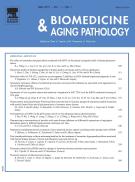The ⍺-asarone/clofibrate hybrid compound, 2-methoxy-4-(2-propenyl)phenoxyacetic acid (MPPA), is endowed with neuroprotective and anticonvulsant potentialities - 09/12/11
 , Pierre Maurois b, Pierre Bac b, Jean Jacques Vanden Eynde c, Joaquίn Tamariz d, Fernando Labarrios d, Germán Chamorro e
, Pierre Maurois b, Pierre Bac b, Jean Jacques Vanden Eynde c, Joaquίn Tamariz d, Fernando Labarrios d, Germán Chamorro e  , Joseph Vamecq f
, Joseph Vamecq f 
Abstract |
2-methoxy-4-(2-propenyl)phenoxy acetic acid (MPPA) is a synthetic drug previously developed to mimic hypolipidemic activity and reduce side-effects of ⍺-asarone, a vegetal extract used in traditional medicine to treat cardiovascular, neurological and other human disorders. MPPA was here evaluated in a battery of tests previously used to characterize anticonvulsant/neuroprotective and toxic potential of ⍺-asarone in mice. MPPA toxicity was limited and doses up to 100mg/kg induced neither hypothermia, nor reduction of spontaneous locomotor activity nor failure in rotarod test. Dose-dependent potentiation of the pentobarbital-induced sleeping was, however, observed at doses higher than 12.5mg/kg. Little or no protection was provided by MPPA against seizures induced by N-methyl-D-aspartate. Moderate protection against subcutaneous pentylenetetrazol- and picrotoxin-induced seizures in mice, along with potentiation of pentobarbital-induced sleep, suggested GABAergic mechanisms. In maximal electroshock-induced seizures, MPPA protected 20% tested mice at 30mg/kg and shortened recovery phase in convulsing mice, suggesting some action on neuronal voltage-gated sodium channels. High efficacy of MPPA was further observed in magnesium-dependent audiogenic seizures test, a murine model responsive to a variety of anticonvulsant, neuroprotective and antioxidant compounds. In this test, 50% animals were protected by 10mg/kg MPPA, highlighting strong brain protective potential. In vitro, MPPA exhibited a superoxide-scavenging capacity about two-fold higher than that of ⍺-asarone. Taken as a whole, present data support that MPPA is less toxic and more brain protective than ⍺-asarone, and represents a worthy emerging neuroprotective/anticonvulsant compound endowed with a large activity spectrum including antioxidant, neuroprotective-like, moderate pro-GABAergic and sodium blockade mechanisms.
Le texte complet de cet article est disponible en PDF.Keywords : 2-Methoxy-4-(2-propenyl) phenoxyacetic acid, Neuroprotective, Anticonvulsant and antioxidant properties, Chemical, Electrical and audiogenic seizure tests, Magnesium deficiency, Clofibrate, ⍺-asarone
Plan
Vol 1 - N° 4
P. 210-215 - octobre 2011 Retour au numéroBienvenue sur EM-consulte, la référence des professionnels de santé.
L’accès au texte intégral de cet article nécessite un abonnement.
Déjà abonné à cette revue ?

